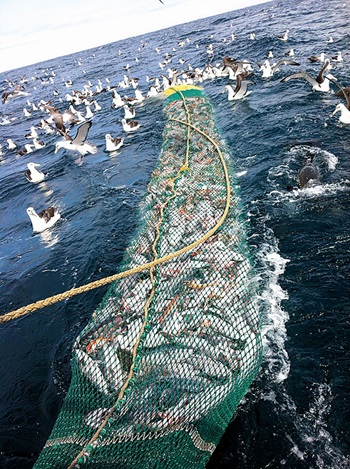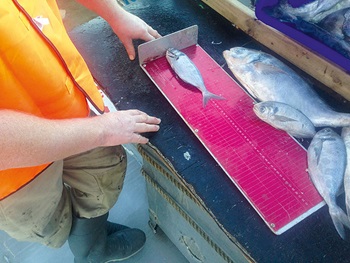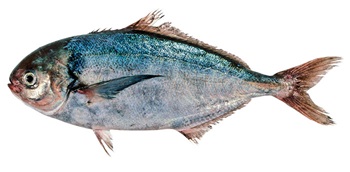How do you work out whether depleted species are on the path to recovery if fishers are doing their best not to catch them?
 Photo: SETFIA
Photo: SETFIA By Karin Derkley
School Shark, Blue Warehou, eastern Gemfish and Orange Roughy were once popular targeted commercial species. But by the mid-2000s their populations had declined dramatically, falling to less than 20 per cent of their benchmark population.
In 2007, the Commonwealth Fisheries Harvest Strategy Policy identified each of the species as being overfished and in need of a rebuilding strategy. They were taken off the targeted list with the goal to recover the stocks to the point where they could again be part of the commercial fishing catch.
Each of these species shares their habitats with other target fish, so it is impossible for fishers to completely avoid them. To protect Orange Roughy (Hoplostethus atlanticus) from fishing, all grounds deeper than 700 metres were closed to fishing, making for one of the largest fishery closures in the world. The regulations also allowed for a minimum and unavoidable amount of incidental catch of the other three depleted species.
Six years down the track, there is evidence that some of the species are improving, but to what degree is difficult to determine. The question remains whether even the small incidental catch allowed is too high to enable populations to rebuild.
That is one of the issues CSIRO fisheries modeller Malcolm Haddon is considering in a study funded by the FRDC project ‘Development of robust methods to estimate the acceptable level of incidental catch of key commercial and protected (TEP) species’.
The underlying aim of the study is to find management options that address the problems faced by the species of concern while minimising the inefficiencies imposed on fishing of other species.
The study is focusing specifically on the South East Trawl Fishery, which Malcolm Haddon says is a classic example of a mixed fishery that includes species with legacy problems. But the project also aims to come up with answers that could theoretically apply to fisheries all over the world.
“What we’re looking for are generic answers on how you can determine the impact of incidental catches, and suggestions based on the implications of a certain course of action.”
So far the study has thrown up as many questions as answers. It has also highlighted the paradox that by reducing the incidental catch of these species it has become difficult to assess the true nature of their stock status.
Some might argue that an approach to assisting species such as School Shark (Galeorhinus galeus) and Blue Warehou (Seriolella brama) to recover would be through a zero total allowable catch on their incidental catch.
However, Malcolm Haddon says that in a mixed fishery such as the South East Trawl Fishery, where it is impossible to avoid all incidental catches, the rules would only force fishers to discard any such catches over the side.
“Our overall aim is to minimise fishing mortality, and encouraging fishers to discard them is not going to achieve that,” he says, adding that he thinks Australian fishers are already doing a great deal to avoid those non-targeted species.
“Australian fishers have a very good record of doing all they can to implement mitigation measures against catching threatened species, such as some seabirds, and they are developing their own ways of cooperating to assist each other to avoid catching depleted species.”
Simon Boag, CEO of the South East Trawl Fishing Industry Association (SETFIA), says his members have a code of conduct that requires them to notify each other when they encounter relatively large numbers of eastern Gemfish (Rexea solandri).
 SETFIA crew operating in the South East Trawl Fishery volunteer to measure Blue Warehou to assist research assessing species recovery.
SETFIA crew operating in the South East Trawl Fishery volunteer to measure Blue Warehou to assist research assessing species recovery. Photo: SETFIA
“On the east coast, for instance, if more than a third of their catch consists of Gemfish, they radio this information out to other fishers in the area, and they all move to a different depth,” he says.
They are also required to report all bycatch, including discards, and to welcome observers on their vessels.
“The system has been working incredibly well, to the point where the catch of eastern Gemfish and Blue Warehou is so small as to be immaterial,” Simon Boag says.
But he appreciates the irony that the success of these avoidance measures means there is now not enough data from which to draw any substantive findings on how these species are recovering.
“Our members have been working so hard to avoid catching these species that it means we don’t have many records,” he says.
“So we really have no idea of what is happening with these species. It may well be that the species is okay, but we don’t have the means to say one way or another.”
Malcolm Haddon says that even reports by fishers of significant incidental catches can be misleading as data. One fisher, for example, recently reported catching two tonnes of Blue Warehou one day and another three tonnes the next day, 15 nautical miles from the original catch.
“It was pure chance, because he had deliberately moved on from the original site,” Malcolm Haddon says.
“So you can’t really rely on that data to give you an indication of whether or not the population has recovered.”
Complicating this still further is the question of what impact the incidental catch is having on a stock whose populations are down.
Simon Boag says the incidental catch of species such as Blue Warehou and eastern Gemfish is now so small that it should have no material effect on the rebuilding of stocks.
“We’re catching at most 50 to 100 tonnes of these species a year, which is nothing really in a fishery of more than 12,000 tonnes.”
Environmental changes could be one contributing factor. Malcolm Haddon points to recent work by researcher Sally Wayte, whose research found that below-average recruitment of Jackass Morwong (Nemadactylus macropterus) since 1968 may have been caused by a change in the East Australian Current interacting with the species’ unusual recruitment biology, resulting in a decline in their reproductive success.
“It might be that the productivity of these other species has also declined to the point where they can’t get back up again,” Malcolm Haddon says.
“It may be that their competitors or their predators may have boomed, or that the embayment environments where juveniles grow may have been impacted by run-off.”
For Simon Boag, while it is frustrating that there is so little hard data to indicate the stock health of the three species, it is also important to emphasise that these species represent just 10 per cent of the 30 species currently designated as unavoidable incidental catch.
“Fish are not like cows in a paddock where you can easily count them. We have to use science and maths to estimate their populations, and really in that light it’s pretty amazing that we have good estimates of the biomass of 90 per cent of that fish stock, and only 10 per cent where we don’t.”
Gathering data

 Top: Blue Warehou, Seriolella brama.
Top: Blue Warehou, Seriolella brama. Below: Gemfish, Rexea solandri.
Photos: CSIRO
While fishers are doing all they can to avoid catching fish such as Blue Warehou and eastern Gemfish, it means the catch-per-unit-effort measure is no longer a relevant indication of stocks. This has led the industry to seek other information that could be used to create a new Index of Abundance.
One potentially useful set of data is the length measurements of species caught in incidental catches.
Length is an indicator of age, and the frequency with which fish of certain lengths appear in a catch may indicate whether the population is growing or contracting, says Simon Boag, CEO of the South East Trawl Fishing Industry Association (SETFIA).
SETFIA has partnered with the FRDC and the Australian Fisheries Management Authority to collect the data. The crew on participating vessels have so far measured the length frequencies from more than 5000 Blue Warehou.
“We’re really proud of the effort that our members have put in to this,” Simon Boag says.
The length frequency data is contributing to a spawner per recruit analysis that Simon Boag hopes will indicate the reproductive capacity of the species.
“We’re not expecting any specific numbers, but it might give us a rough idea of whether species are improving or not,” he says.
CSIRO fisheries scientist Malcolm Haddon says collecting length frequencies is a good initiative.
“Gathering any data in such a data-poor area is helpful. And those working in the industry on the water are certainly the right people to be collecting that kind of data.”
Further work will be carried out to see whether the data will be able to feed into a more accurate assessment of stocks, he says.
FRDC Research Code: 2011-028, 2013-015
More information
Malcolm Haddon, 03 6232 5097
malcolm.haddon@csiro.au





